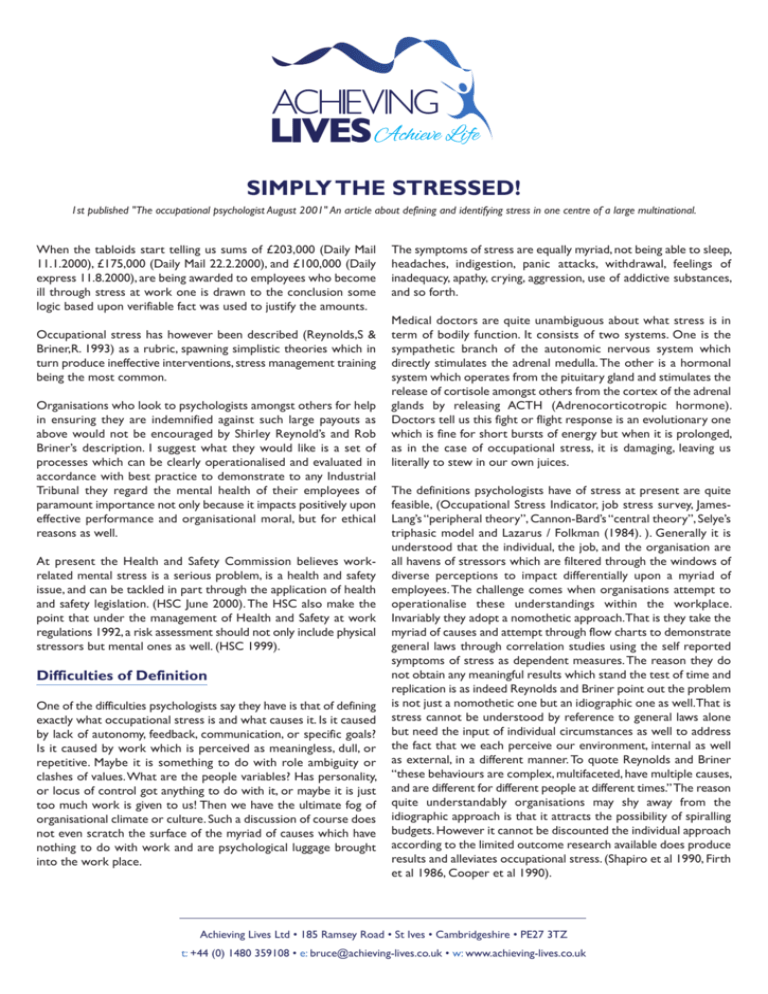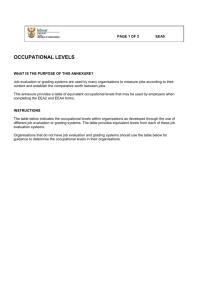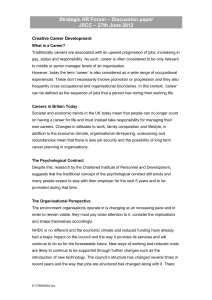N and C Glass - Achieving Lives
advertisement

SIMPLY THE STRESSED! 1st published "The occupational psychologist August 2001" An article about defining and identifying stress in one centre of a large multinational. When the tabloids start telling us sums of £203,000 (Daily Mail 11.1.2000), £175,000 (Daily Mail 22.2.2000), and £100,000 (Daily express 11.8.2000), are being awarded to employees who become ill through stress at work one is drawn to the conclusion some logic based upon verifiable fact was used to justify the amounts. Occupational stress has however been described (Reynolds,S & Briner,R. 1993) as a rubric, spawning simplistic theories which in turn produce ineffective interventions, stress management training being the most common. Organisations who look to psychologists amongst others for help in ensuring they are indemnified against such large payouts as above would not be encouraged by Shirley Reynold’s and Rob Briner’s description. I suggest what they would like is a set of processes which can be clearly operationalised and evaluated in accordance with best practice to demonstrate to any Industrial Tribunal they regard the mental health of their employees of paramount importance not only because it impacts positively upon effective performance and organisational moral, but for ethical reasons as well. At present the Health and Safety Commission believes workrelated mental stress is a serious problem, is a health and safety issue, and can be tackled in part through the application of health and safety legislation. (HSC June 2000). The HSC also make the point that under the management of Health and Safety at work regulations 1992, a risk assessment should not only include physical stressors but mental ones as well. (HSC 1999). Difficulties of Definition One of the difficulties psychologists say they have is that of defining exactly what occupational stress is and what causes it. Is it caused by lack of autonomy, feedback, communication, or specific goals? Is it caused by work which is perceived as meaningless, dull, or repetitive. Maybe it is something to do with role ambiguity or clashes of values. What are the people variables? Has personality, or locus of control got anything to do with it, or maybe it is just too much work is given to us! Then we have the ultimate fog of organisational climate or culture. Such a discussion of course does not even scratch the surface of the myriad of causes which have nothing to do with work and are psychological luggage brought into the work place. The symptoms of stress are equally myriad, not being able to sleep, headaches, indigestion, panic attacks, withdrawal, feelings of inadequacy, apathy, crying, aggression, use of addictive substances, and so forth. Medical doctors are quite unambiguous about what stress is in term of bodily function. It consists of two systems. One is the sympathetic branch of the autonomic nervous system which directly stimulates the adrenal medulla. The other is a hormonal system which operates from the pituitary gland and stimulates the release of cortisole amongst others from the cortex of the adrenal glands by releasing ACTH (Adrenocorticotropic hormone). Doctors tell us this fight or flight response is an evolutionary one which is fine for short bursts of energy but when it is prolonged, as in the case of occupational stress, it is damaging, leaving us literally to stew in our own juices. The definitions psychologists have of stress at present are quite feasible, (Occupational Stress Indicator, job stress survey, JamesLang’s “peripheral theory”, Cannon-Bard’s “central theory”, Selye’s triphasic model and Lazarus / Folkman (1984). ). Generally it is understood that the individual, the job, and the organisation are all havens of stressors which are filtered through the windows of diverse perceptions to impact differentially upon a myriad of employees. The challenge comes when organisations attempt to operationalise these understandings within the workplace. Invariably they adopt a nomothetic approach.That is they take the myriad of causes and attempt through flow charts to demonstrate general laws through correlation studies using the self reported symptoms of stress as dependent measures. The reason they do not obtain any meaningful results which stand the test of time and replication is as indeed Reynolds and Briner point out the problem is not just a nomothetic one but an idiographic one as well.That is stress cannot be understood by reference to general laws alone but need the input of individual circumstances as well to address the fact that we each perceive our environment, internal as well as external, in a different manner. To quote Reynolds and Briner “these behaviours are complex, multifaceted, have multiple causes, and are different for different people at different times.” The reason quite understandably organisations may shy away from the idiographic approach is that it attracts the possibility of spiralling budgets. However it cannot be discounted the individual approach according to the limited outcome research available does produce results and alleviates occupational stress. (Shapiro et al 1990, Firth et al 1986, Cooper et al 1990). Achieving Lives Ltd • 185 Ramsey Road • St Ives • Cambridgeshire • PE27 3TZ t: +44 (0) 1480 359108 • e: bruce@achieving-lives.co.uk • w: www.achieving-lives.co.uk Solution to Definitional Problems One solution to defining stress is to recognise we often make category errors. This occurs according to the philosophy of logic when items are assumed to exist independently of the categories to which they belong. It is like saying Ok I can see the bedroom, I can see the living room, and I can see the kitchen but where is the house. Literally one does not see the wood for the trees. Graham Wagstaff (1998) has suggested the definition of hypnosis has hitherto suffered the same fate. He goes on to make the point that the term hypnosis does not exist independently of it’s component parts such as motivation, relaxation, absorption, beliefs, expectancy, concentration, and suggestibility to name but a few. In the same way in defining stress it does not make sense to do so in a pithy manner which does not do full justice to the component parts which constitute it’s existence at any given time. Case History I was called upon by a management Association to conduct a pilot study to evaluate managerial stress levels in a depot of a large international company. The depot had let managers go recently because of stress and at the time had three off with stress. The company’s own managerial employee survey (N=7667) had noted a decreased score in 17 of 20 attribute dimensions evaluated. 2 had stayed the same and only one had improved: “adequacy of training for new joiners”. This was a direct comparison with the previous year. The OSI and MBTI was used in conjunction to see if there was any common variation between type and Stress level. A small scale survey of 26 managers found overall job satisfaction was down by almost a standard deviation compared with appropriate norms supplied by the test publishers and mental and physical stress scores were up by 0.8 and over 1 S.D. respectively. The dimensions causing greatest “stress” were “Organisational Structure and Climate” followed by “Relationships with other people” and “Career and achievement”. Locus of control was one standard deviation in the direction which tends to increase stress, -external. One to one interviews with managers seemed to corroborate the picture the OSI was painting. Senior management was being blamed as ineffective, there was a perceived lack of communications between functions and hierarchies as well as little systemic thinking, too much paperwork, low moral, no career opportunities, and bad relationships between colleagues. The MBTI showed of, the 23 managers who responded 19 were S.J’s. The 4 managers who did not fall into the SJ bracket and who were intuitives or perceptives both individually and collectively scored higher concerning both mental and physical stress as the table below shows. Dimension N&F SJ’s Norm (N=1556) Mental Health 69.6 58.2 48.7 (s.d.13.00) Physical Health 42.5 37.9 27.4 (s.d. 8.78) www.achieving-lives.co.uk This suggested, to break the mould and dare to think in a counterorganisa tional way brought about it’s own nemesis. A presentation was given and a report submitted. After a period of 3 months the Management Association contacted me to say how they would like to take a larger sample. However when talking about the possibility of introducing mental stress items into the risk assessments and what actions were being taken to reduce the levels of stress in managers there appeared to be a resignation that this is the way things are. “Notices are put up and everyone ignores them ”.... was the starting point of a list of organisational / political “traumas” which got me thinking about some of Gareth Morgan’s metaphors: Psychic Prison, Political system, and organisational cultures were the ones that sprung to mind. “This company is a very big ship and takes a long time to turn” said the secretary. Conclusion: Having seen many clients from company directors to operational employees at an individual level I know from Kirkpatric levels 1, 2, and 3 evaluation / feedback (level 3 at 6 months) counselling will help relieve stress. By assisting clients to creatively develop more appropriate mental models they can re-enter the same organisations with a greater sense of control, the ability to assert themselves when necessary, more motivation, and with a sense of clarity, purpose, worth and ability. When we think of stress at a more general level in the strategic terms of job specification and to what extent jobs are capable of “enrichment”. In terms of physical environment and shift rotations. In terms of creating a culture where the relationship to best practice is positive and energetic, rather than negative and apathetic. In terms of creating processes for self development and career advancement the answer is simple. It is an individual problem as well as an organisational one. An Approved Code of Practice (APOC) in the near future is a possibility. This follows a discussion document sent out by the Health and Safety Commission in 1999 concerning the management of mental health at work. It is evidential to me that if an APOC is published by the HSC, the individuals who can, who have clout and who care, will have to be the individuals who begin to internalise best practice concerning mental stress both in them selves and in their organisations.They will no longer be able to say “Oh but stress is such an ambiguous concept”, or “I could not foresee the consequences of such an organisational practice” when they attend the industrial tribunal, It could be argued it was a lack of care that gave *Mr John Walker, an area social services officer, his second mental breakdown in the September of 1987. Unless senior employees begin to take individual responsibility for the culture and climate they help create within their organisation it could be argued they too can be similarly accused. * Mr John Walker was awarded £175,000 against his employers Northumberland County Council. This is regarded as the first compensation award for stress in the U.K. References: Cooper.C.L, Sadri,G, Allison,T & Reynolds,P (1990) Stress counselling in the Post Office. Counselling Psychology Quarterly, Vol3 No1 pp3-11. Firth,F & Shapiro,D.A. (1986) An evaluation of psychotherapy for job-related distress. Social and Applied psychology unit, University of Sheffield. Reynolds S & Briner R. (1993) Occupational Psychology conference, Brighton. Shapiro,D.A, Barkham,M, Hardy,G.E & Morrison L,A (1990) The second Sheffield Psychotherapy project: Rationale, design, & preliminary outcome data. British journal of Medical Psychology (1990) 63 pp97-108. Wagstaff GF. (1998) The semantics and physiology of hypnosis as an altered state: towards a definition of hypnosis. (1998) Contemporary Hypnosis Vol15 No 3. Managing Stress at work, discussion document H.S.C. Health & Safety Executive (1999) www.achieving-lives.co.uk








